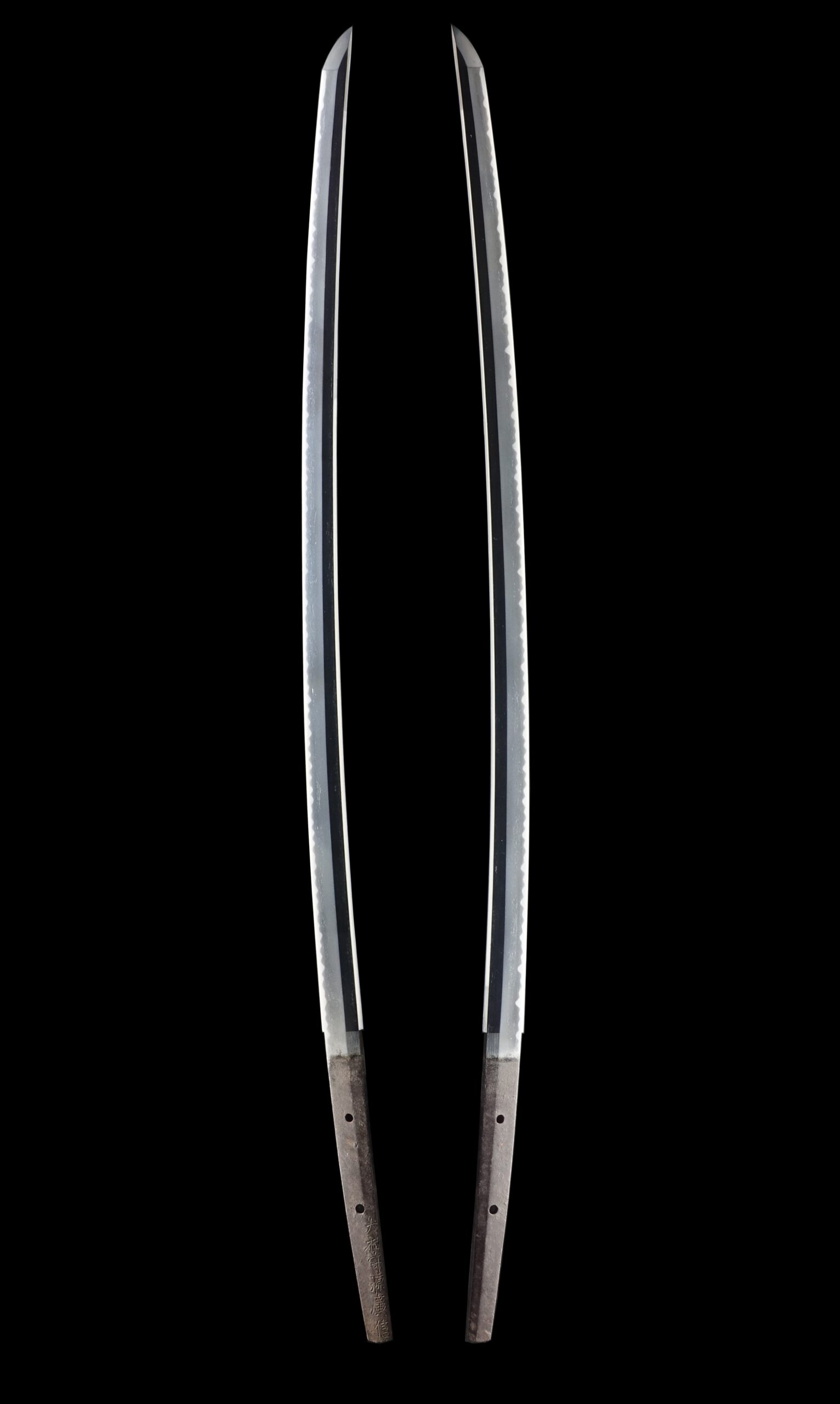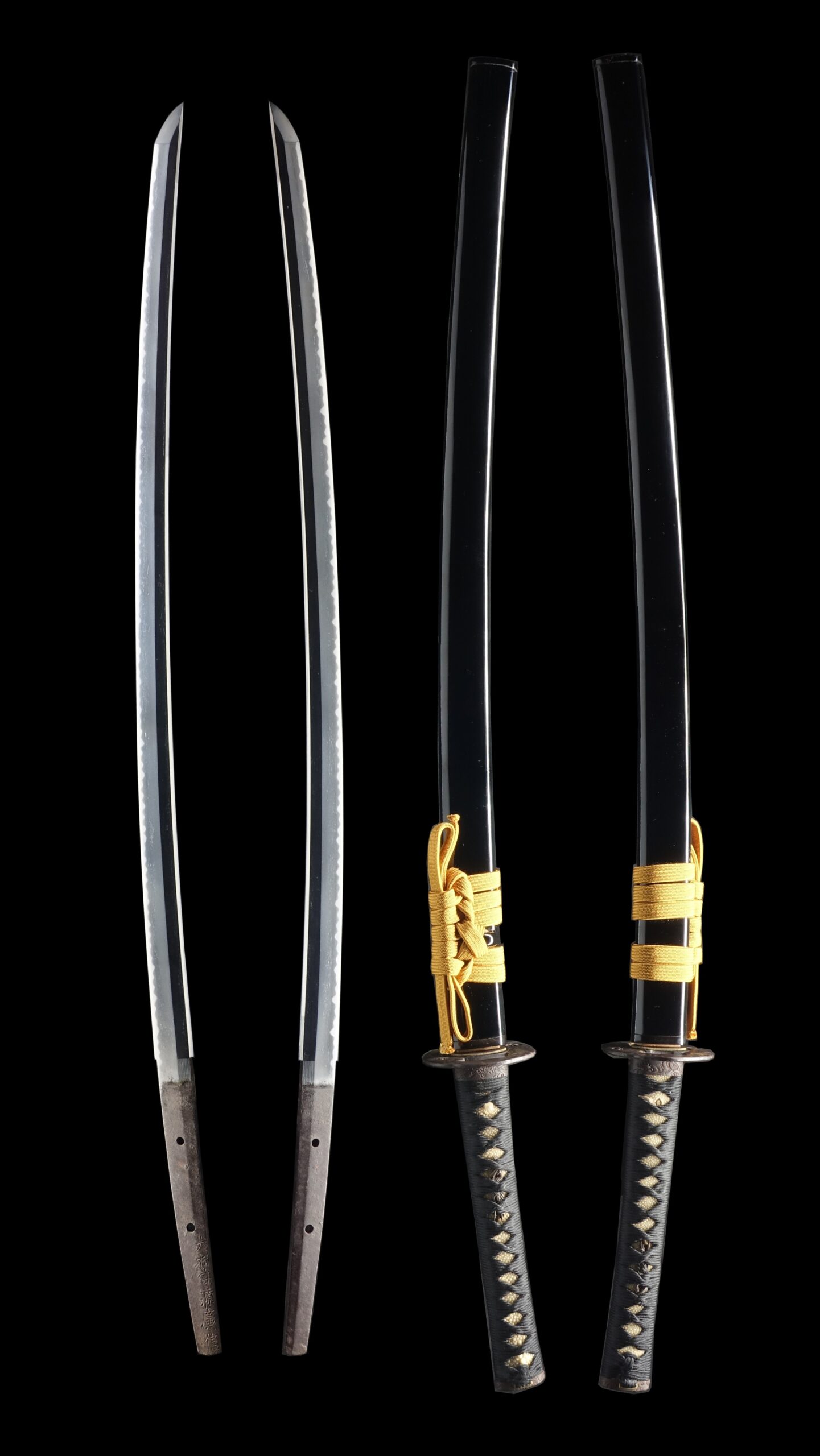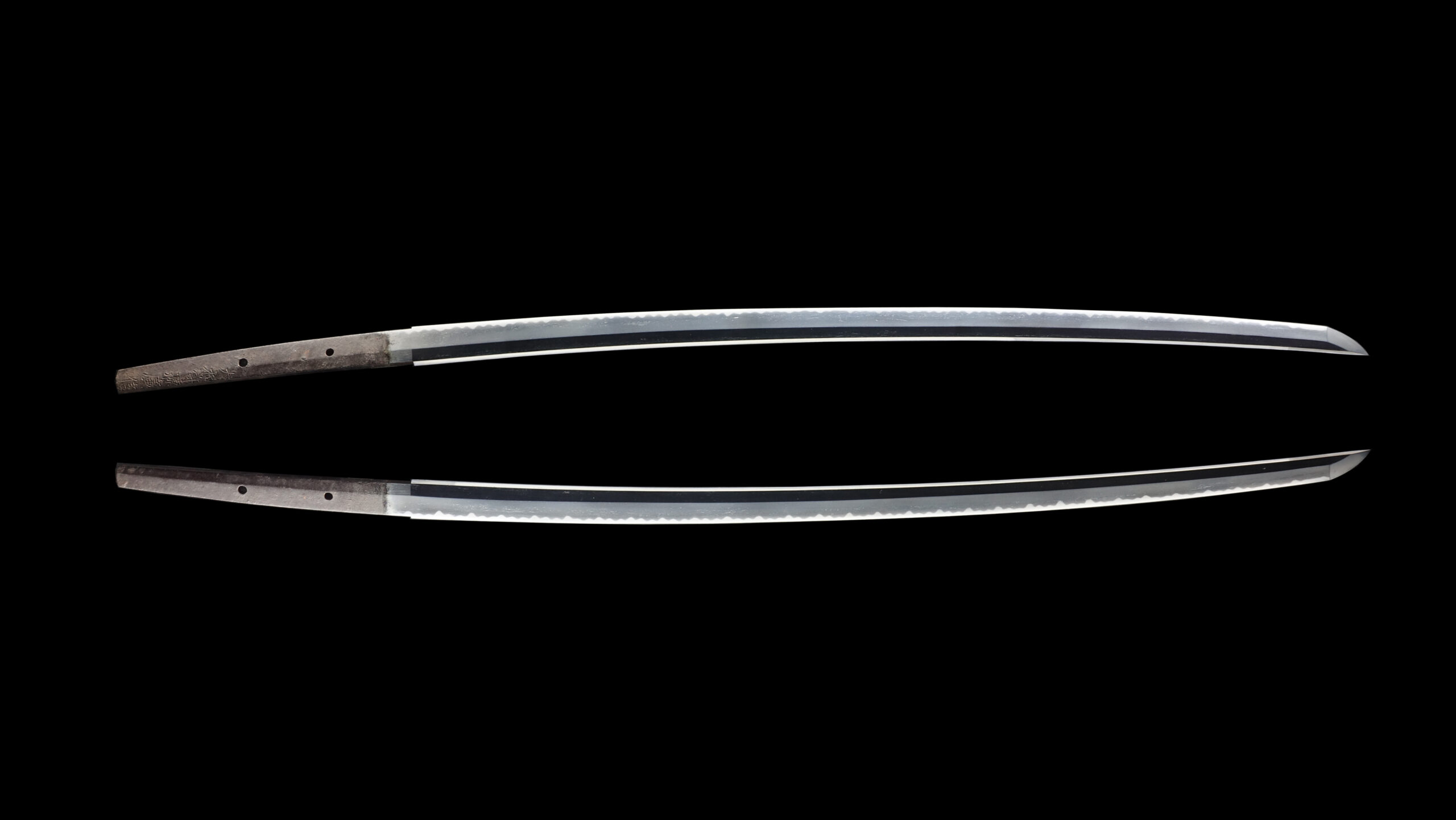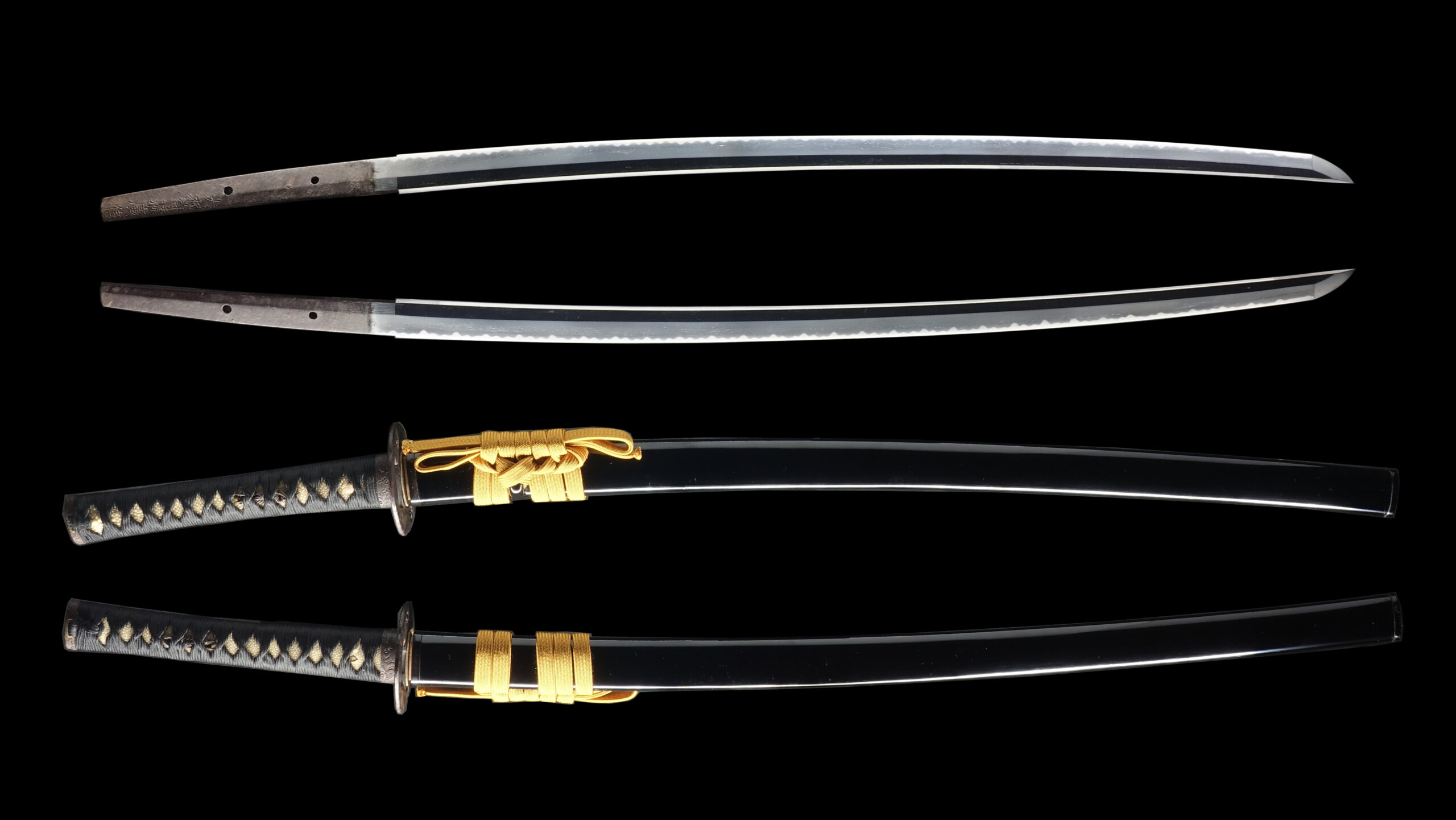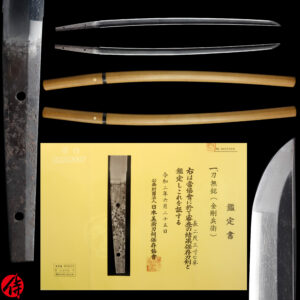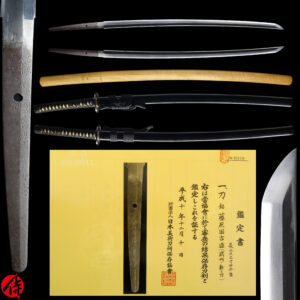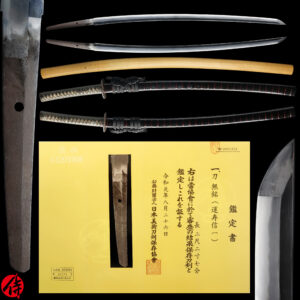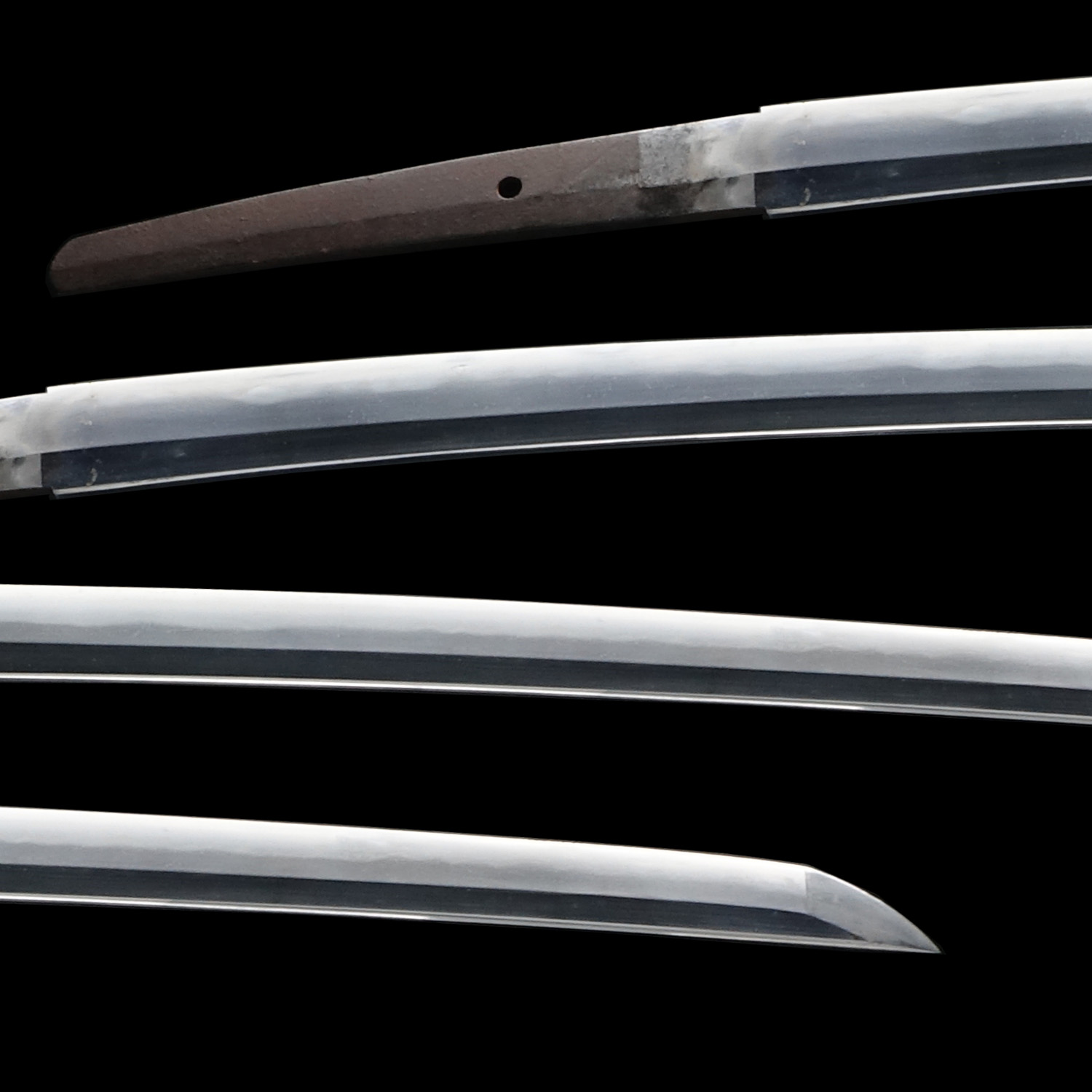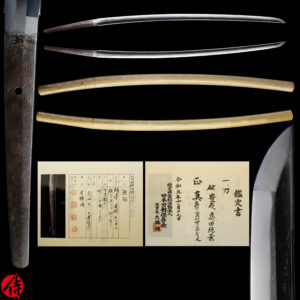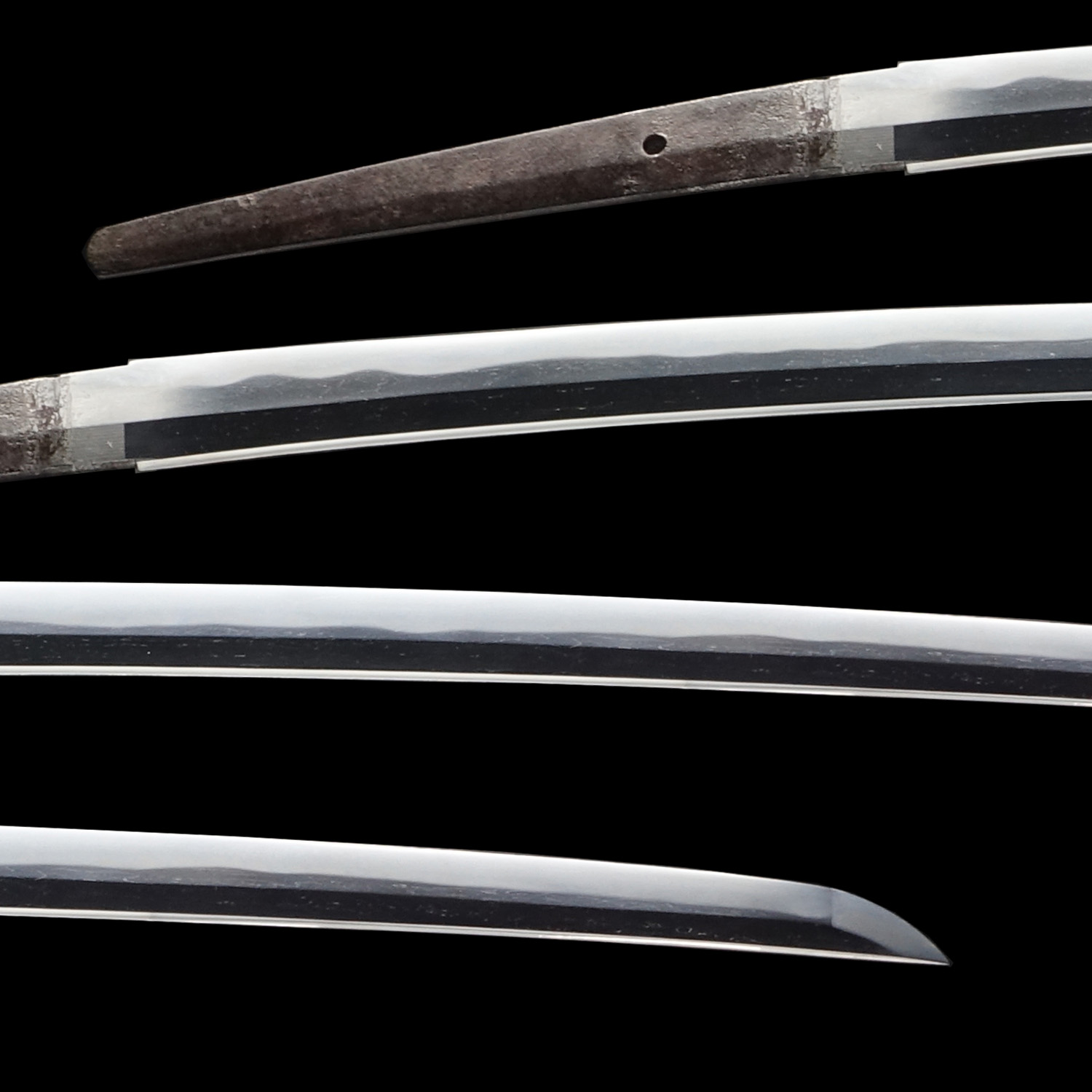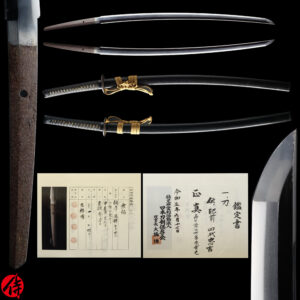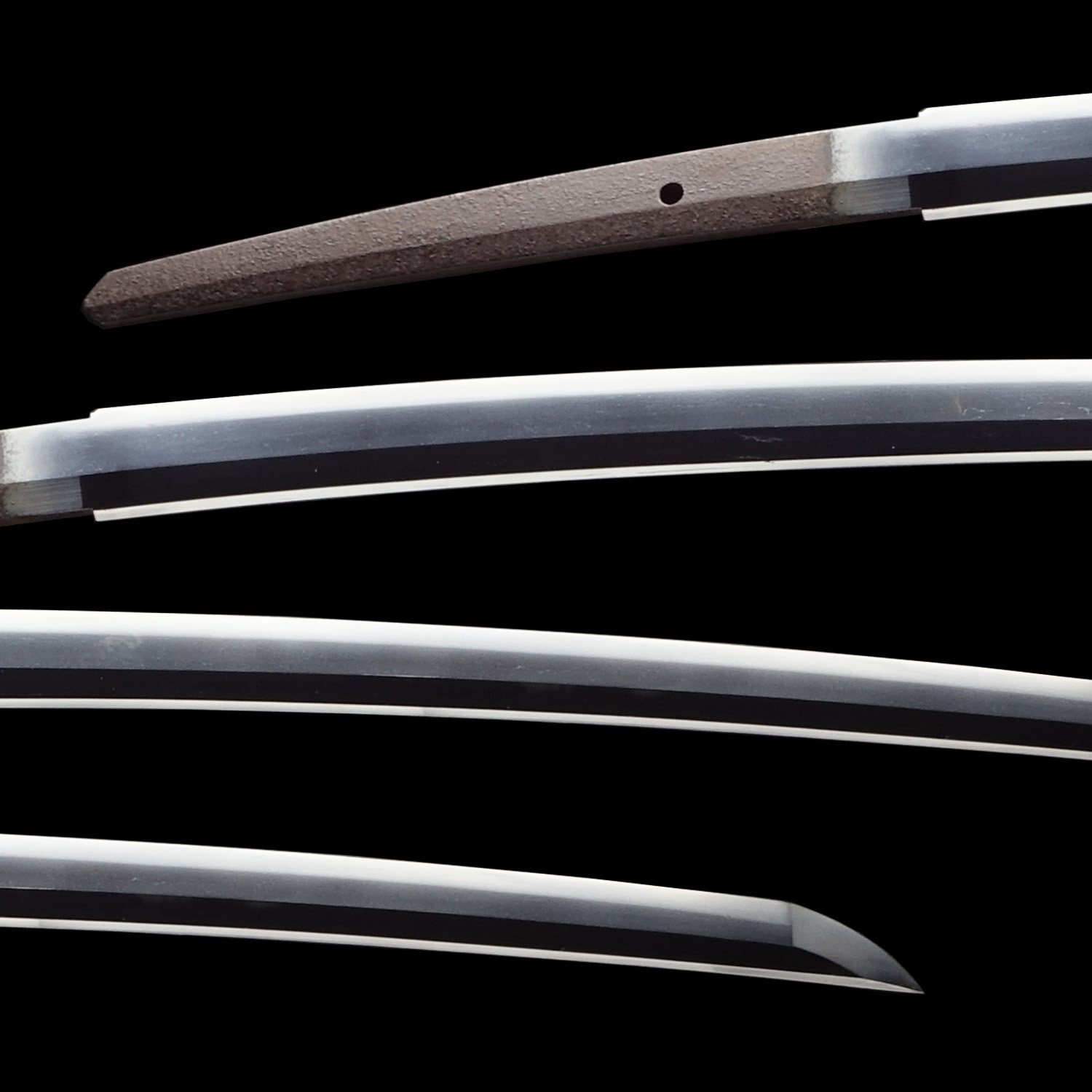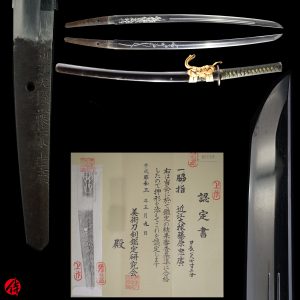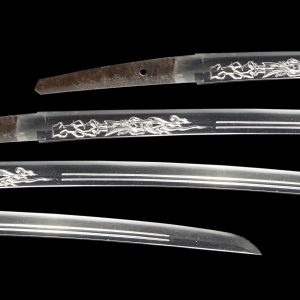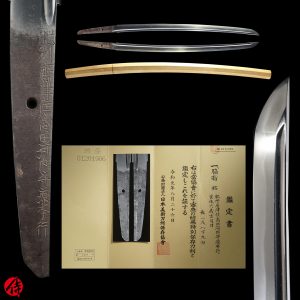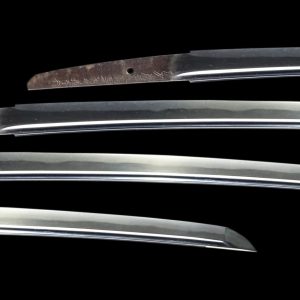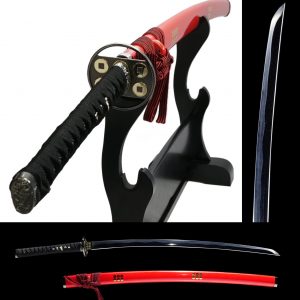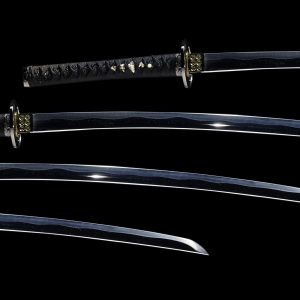Antique Japanese Sword Katana Signed by Yamato no Kami Minamoto Hironobu with NBTHK Hozon Certificate
【Description】
This blade was signed by Yamato no Kami Minamoto Hironobu (大和守源広信) during the Manji era (1658-1661: Early Edo Period), according to its NBTHK appraisal. The maker’s name, Hironobu, lasted four generations, and based on their active period, it was made by the second-gen Hironobu. The first-gen Hironobu was active during the Kan-Ei era (1624-1644). The generations of Hironobu resided in Yamashiro province (Today’s Kyoto prefecture). However, There was a record where the first-gen and second-gen also forged blades in Kishu province (Today’s Wakayama prefecture), ruled by the Kishu Tokugawa clan.
Kishu Tokugawa clan was founded by Tokugawa Yorinobu, a direct lineage from the Tokugawa clan, who ruled the Edo government. Kishu Tokugawa clan is known as GOSANKE, which is eligible to take over Shogun’s position. Considering the fact that the two generations of Hironobu lived in this area. It is highly likely that they forged blades for those who served the Kishu Tokugawa clan.
The second-gen Hironobu received Yamato no Kami in his career. Kami was an honorable official title given by the imperial court for his excellent craftsmanship. There is an engraving of Yamato no Kami on the tang. This indicates that his craftsmanship was highly regarded when he forged this blade. We assume this Katana might have been ordered by a Samurai who resided in Yamashiro province during the early Edo period.
It has a very distinctive Hamon (tempering line). It is called Sanbon Sugi, whose line resembles a small cedar tree/forest growing horizontally.
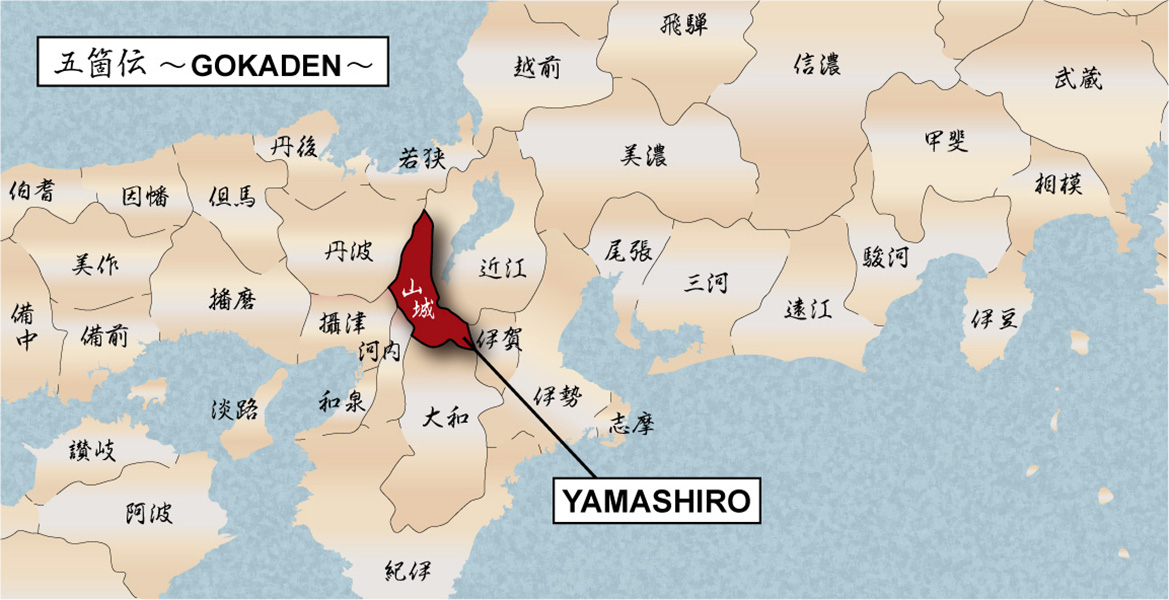
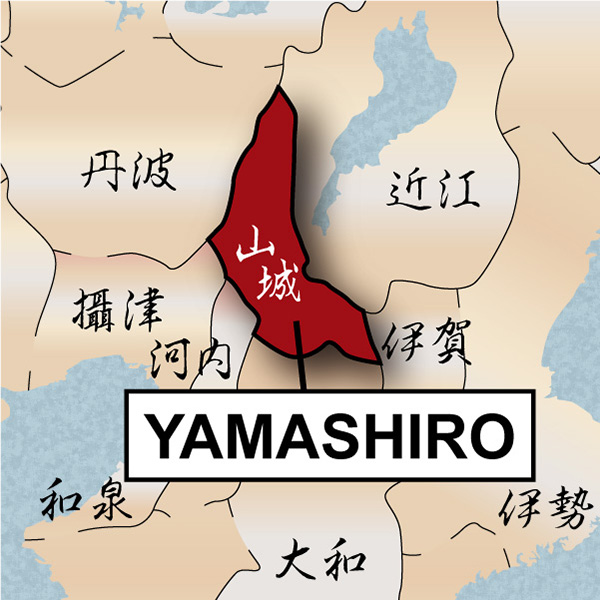
This blade is appraised as a Hozon Touken (保存刀剣) issued by NBTHK (Nihon Bijutsu Touken Hozon Kyokai: 日本美術刀剣保存協会). This authentication paper was only given to authentic Japanese swords, well preserved and high quality with artistic value.
【Blade】
Cutting Edge Length (Nagasa): 68.3 cm ( 26.9 inches)
Curvature (Sori): 1.4 cm (0.55 inches)

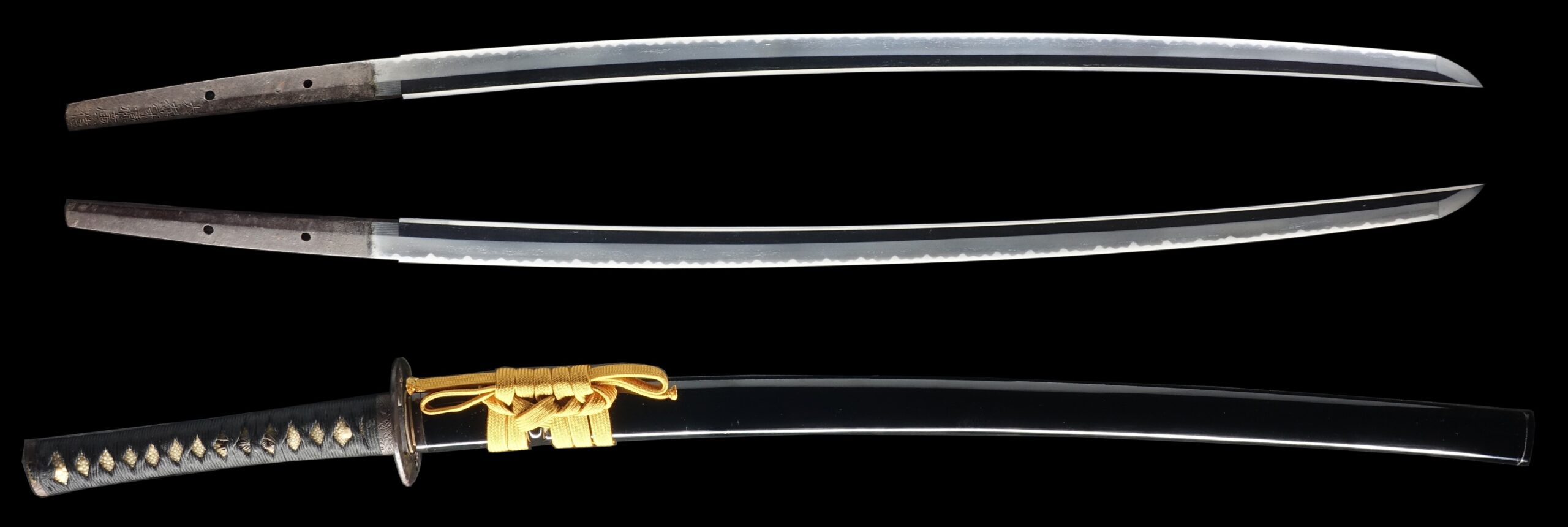
Hamon:
The crystalline structure which forms along the cutting edge of a blade as a result of the hardening process.
Jimon (Jihada):
Visible steel surface pattern created by folding and hammering during forging process.
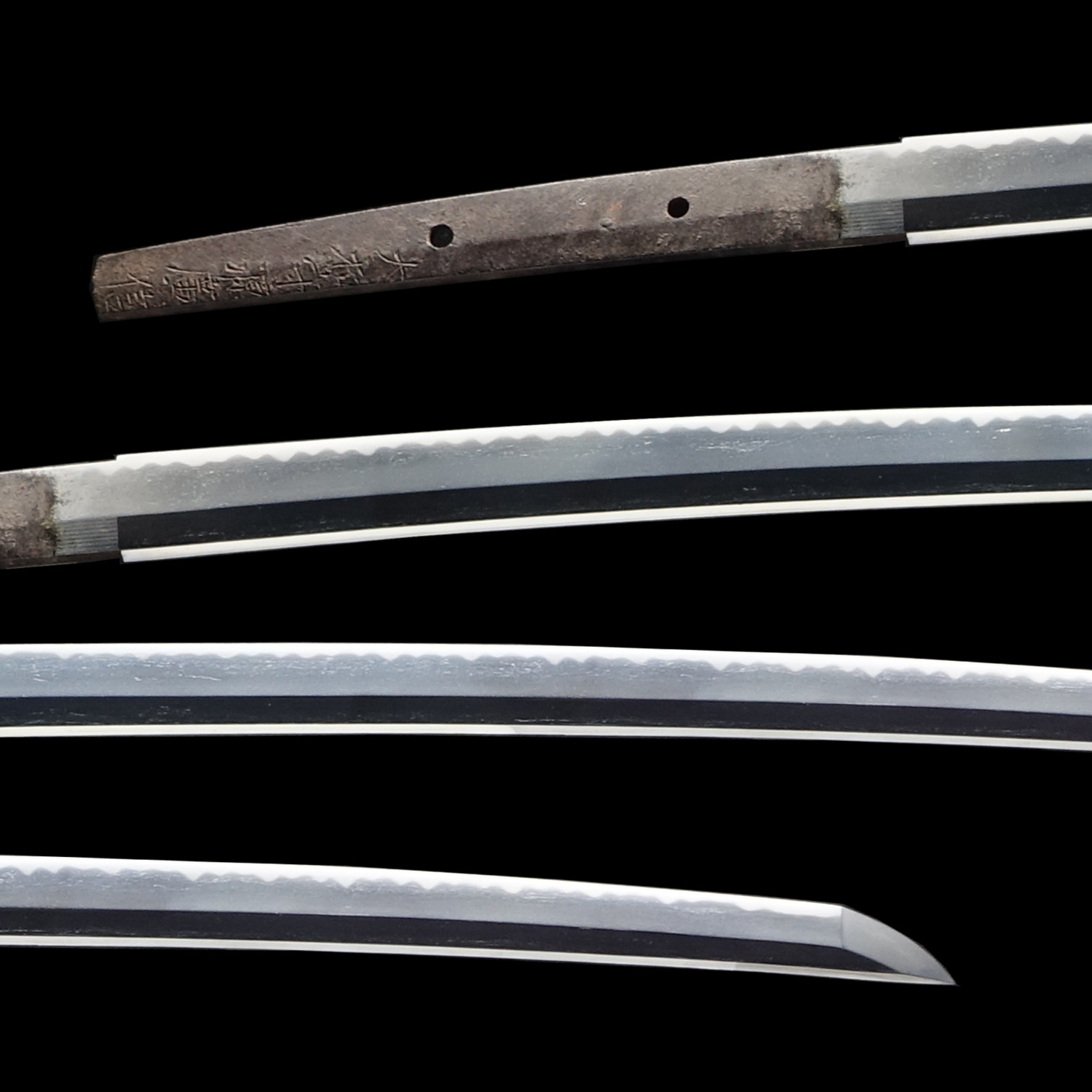
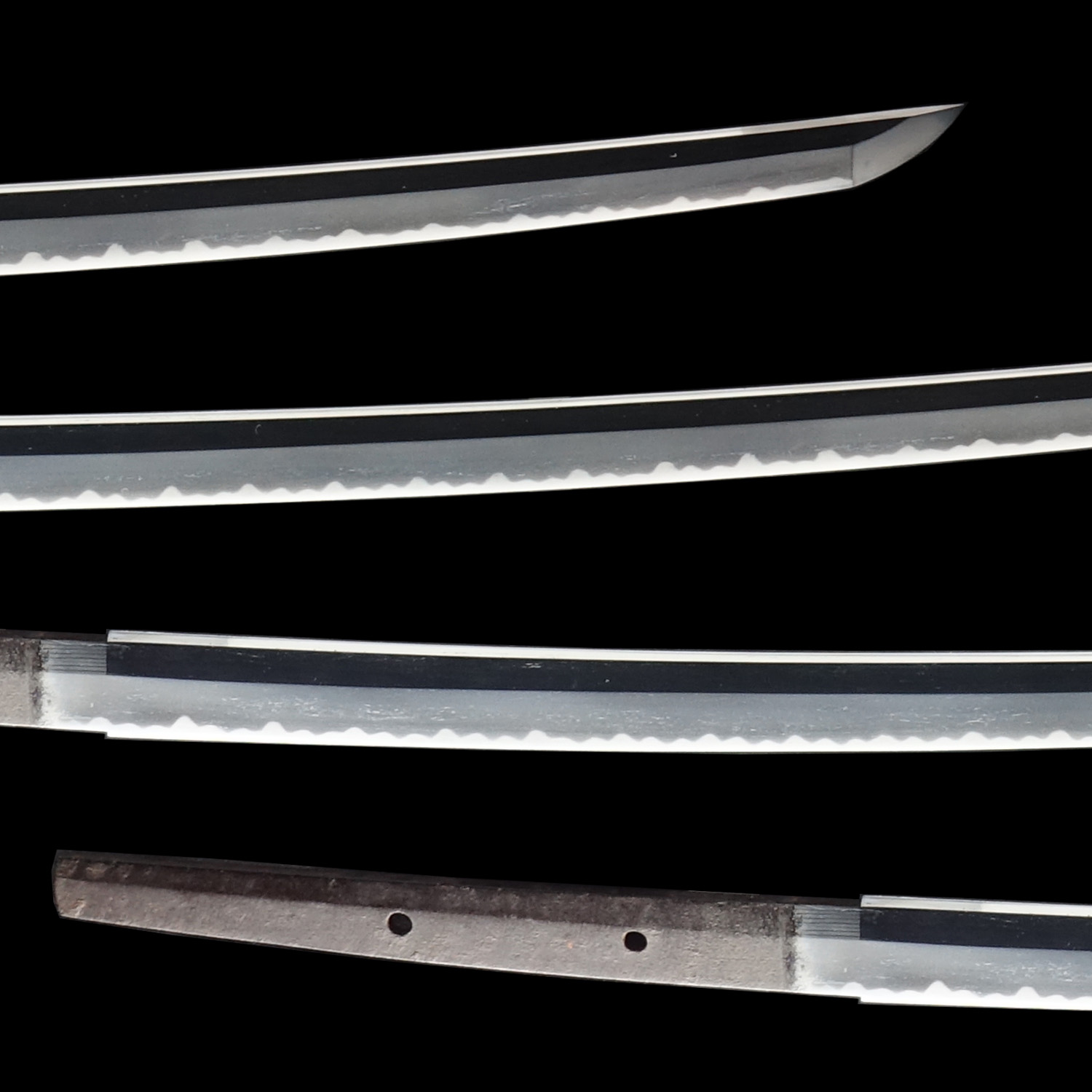
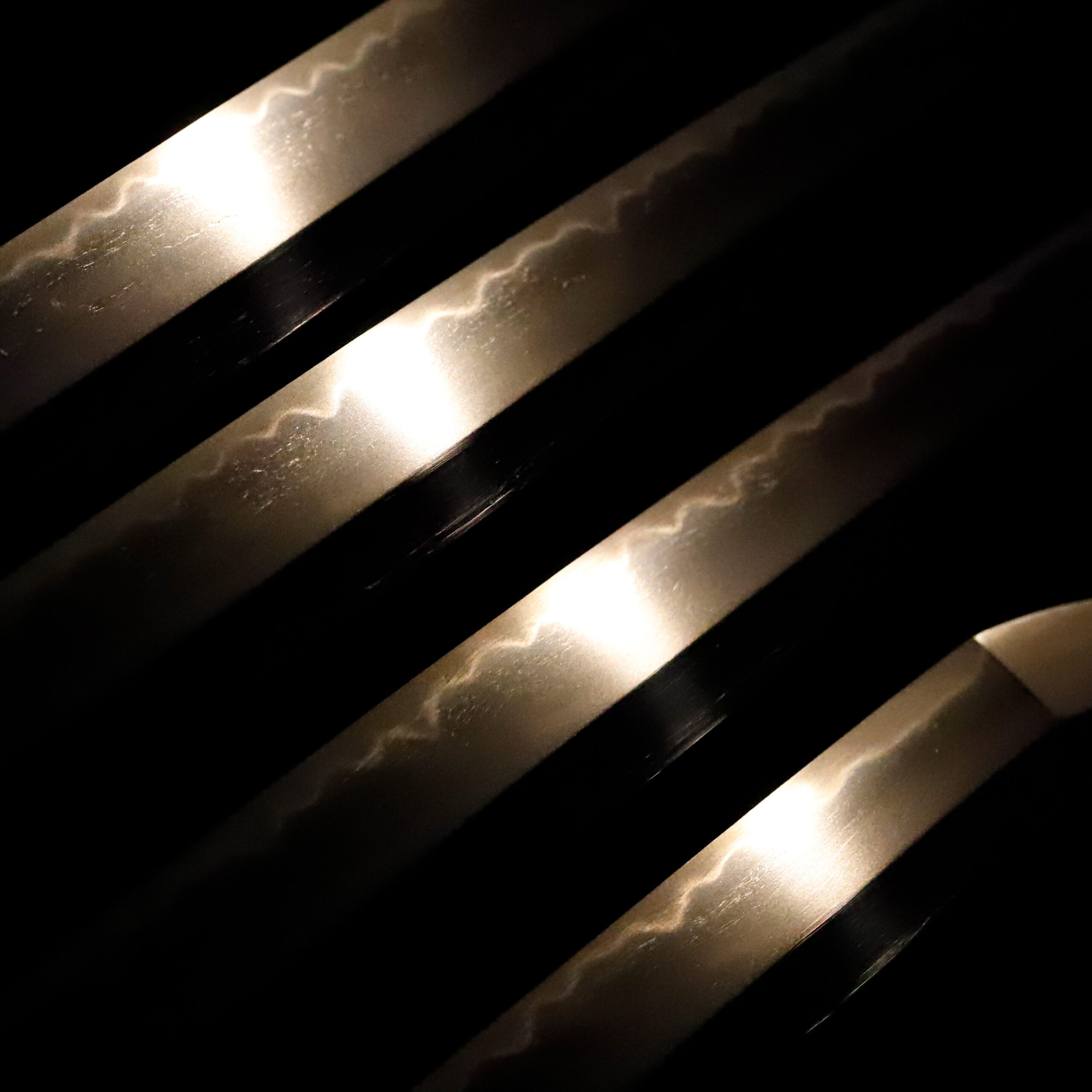
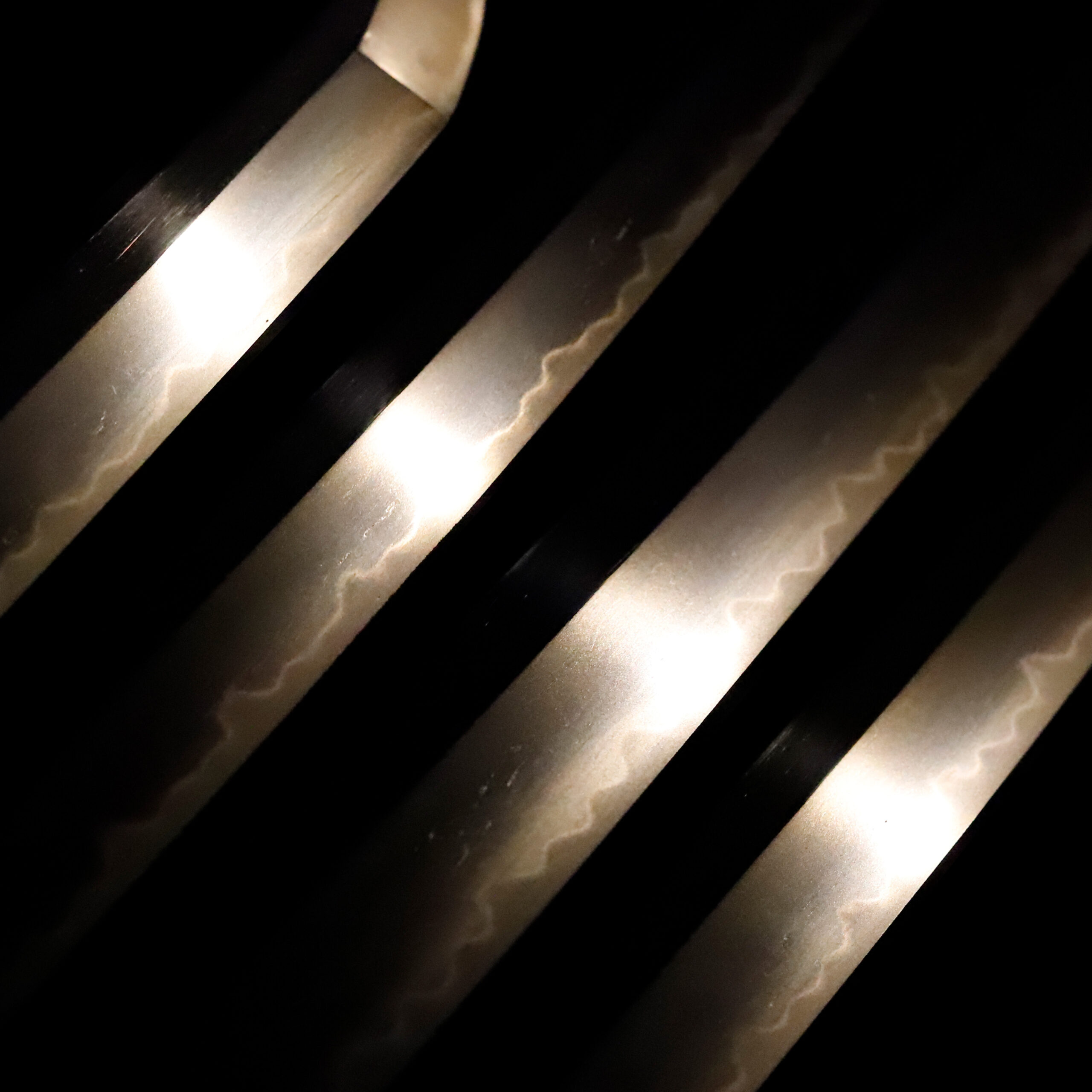
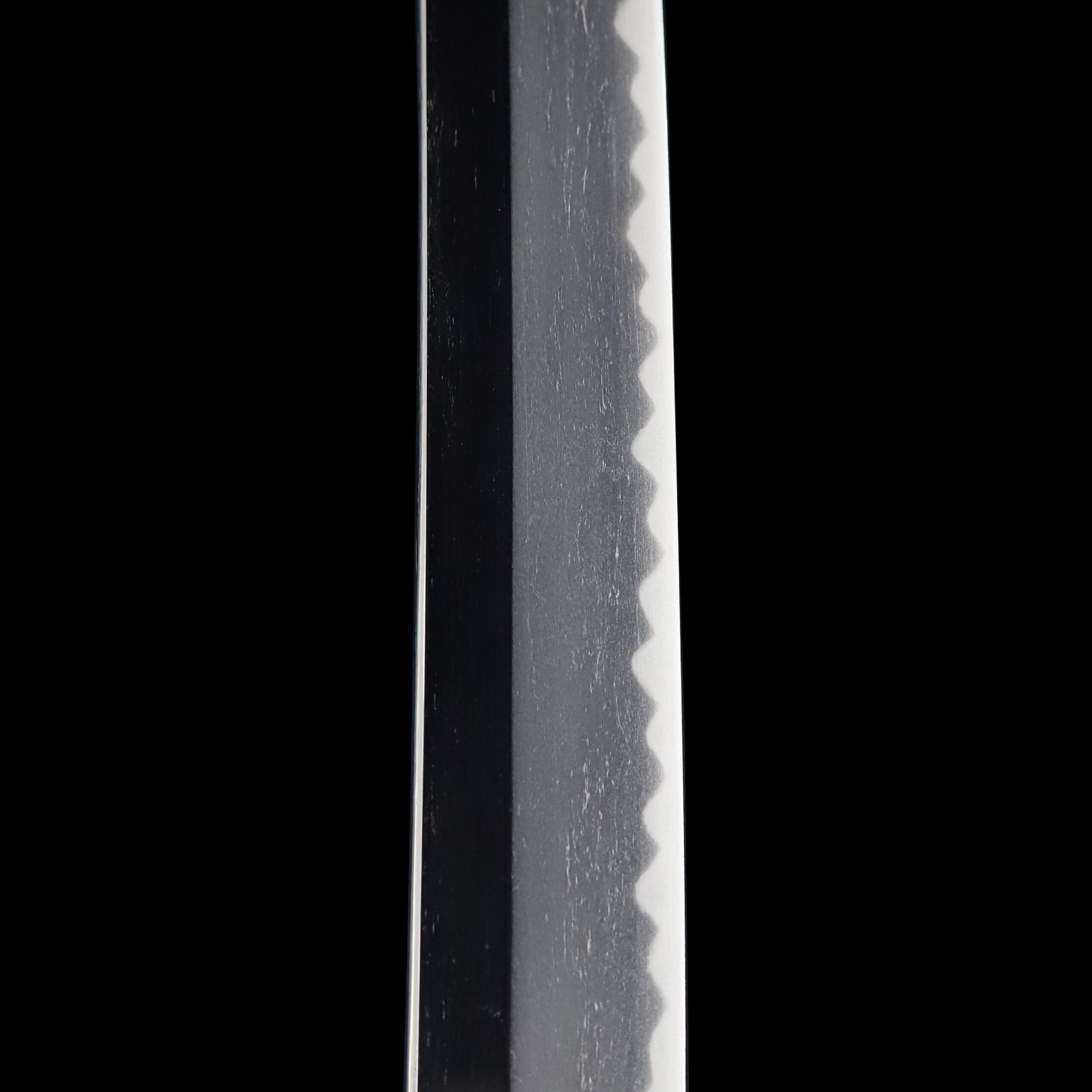
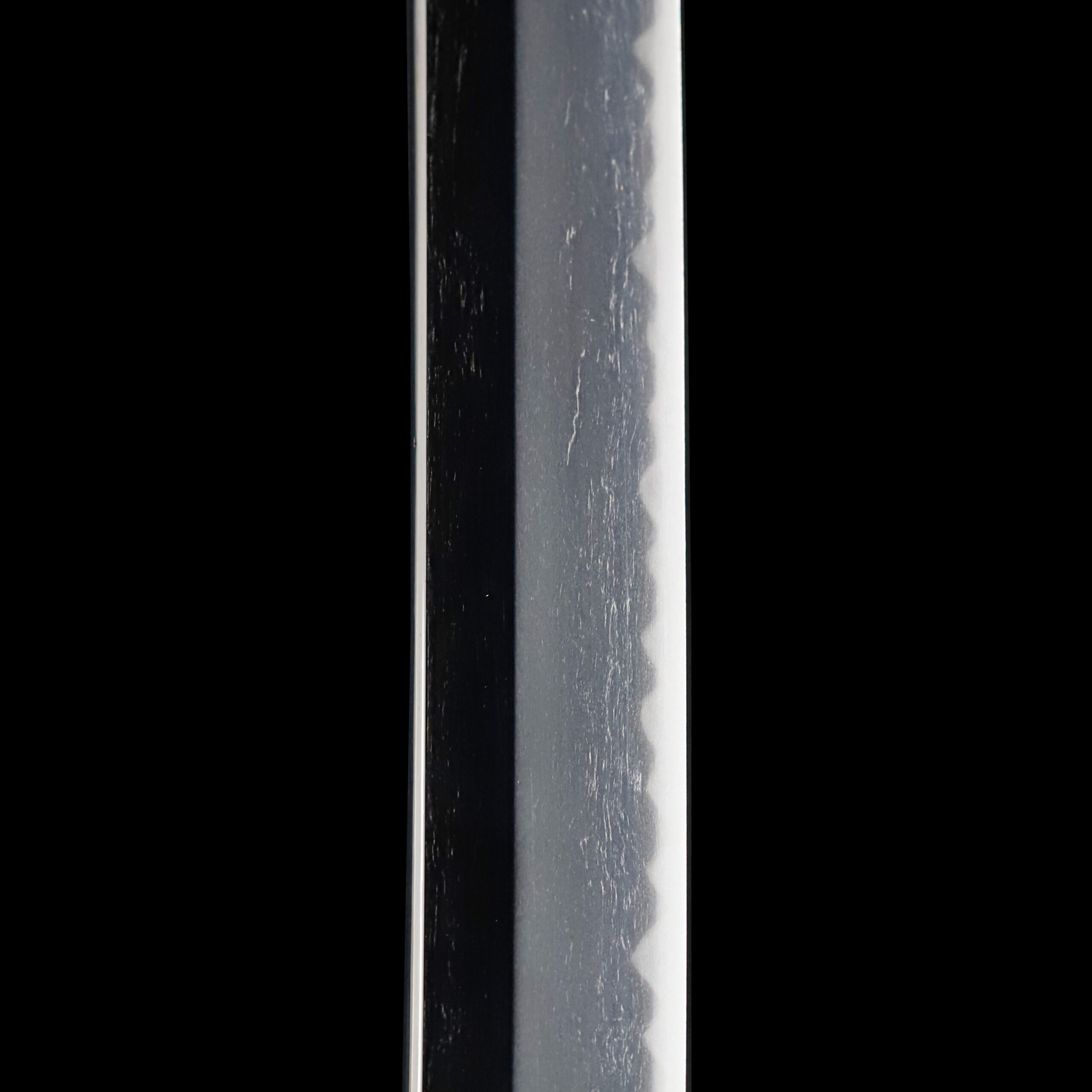
Nakago: Nakago is the tang of the Japanese sword.
Japanese swordsmiths left the black rust on the tang because it prevents red rust while the tang is in its handle. And the discoloration of the tang was created over time, and it is a great indicator for a Japanese sword specialist to estimate when the sword was forged.

Koshirae: Koshirae is the mounting of the Japanese sword. There are several parts that consist of Koshirae such as Saya (Scabbard), Tsuka (Handle), Tsuba (Handguard).
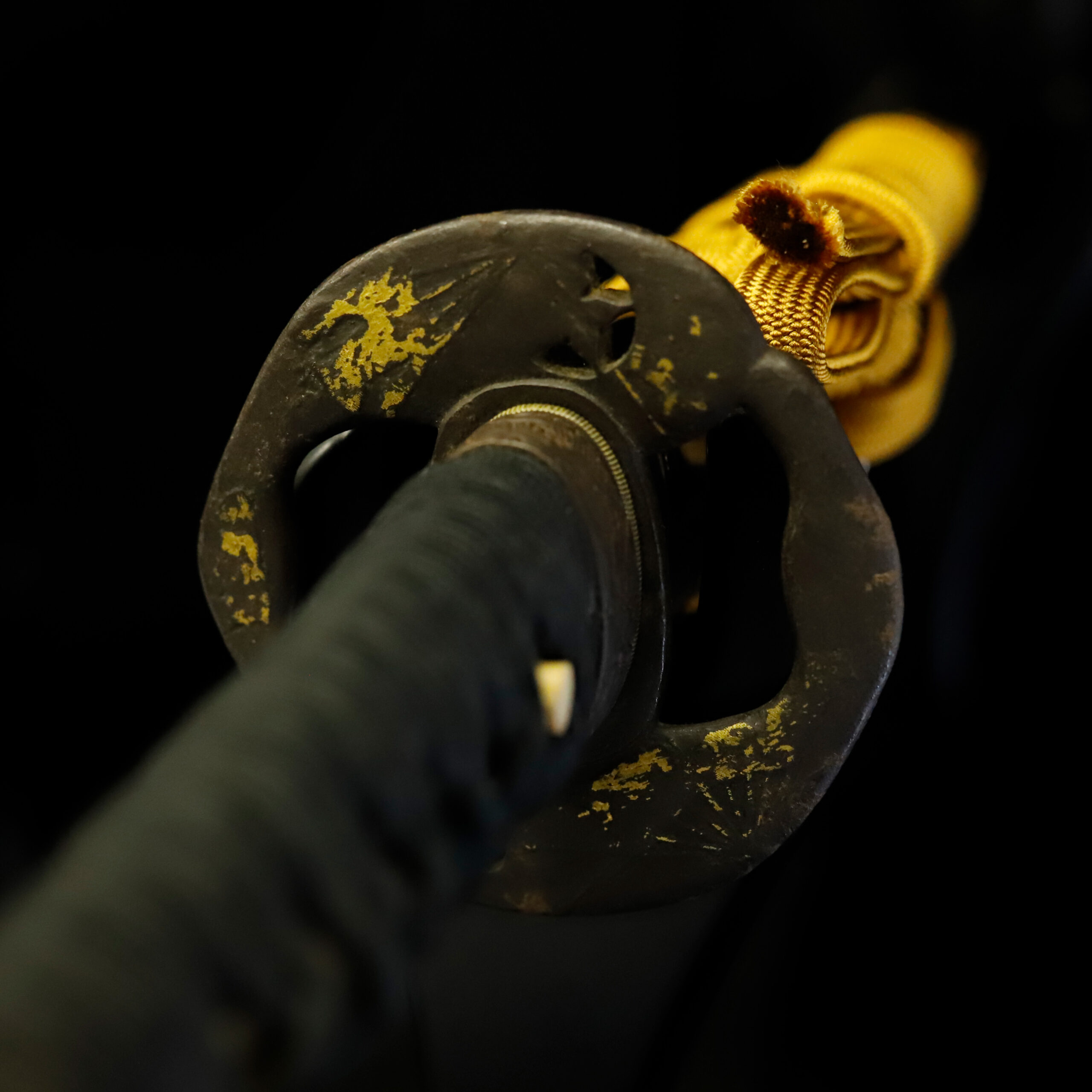
Fuchi-Kashira: A pair of matching sword fittings that cover the upper and bottom parts of its sword hilt.
This Fuchi Kashira’s design theme is the Unryu Zu (雲龍図). It is a combination of dragons and clouds. Initially, dragons were imaginary creatures found in ancient foreign traditions and myths. Furthermore, it is regarded as a symbolic beast of auspicious signs. Its body is likened to nine animals: antlers are deer, the head is a camel, eyes are demons, the neck is a snake, the belly is the Mizuchi (蛟, a mythical animal in Japan that looks like a snake and has a horn and four legs), scales are fish, claws are falcons, palms are tigers and ears are cows. A dragon was thought to reign at the top of all animals because of its odd appearance. Based on our experiences, there are lots of dragon-designed sword mountings. It shows many Samurai warriors favored this dignified beast motif.
About the cloud pattern, clouds bring blessed rain and snow, and their movements significantly affect the day’s weather. Due to its supernatural power, a theory says that gods, spirits, and dragons dwell in the clouds. In Japan, there is a belief that worships dragons as water gods. Since rice cultivation has flourished in this country, people always treat water as an essential resource. We imagine some people wished for a plentiful harvest in the Unryu theme. From such a religious aspect, we could infer that dragon designs were familiar to people.
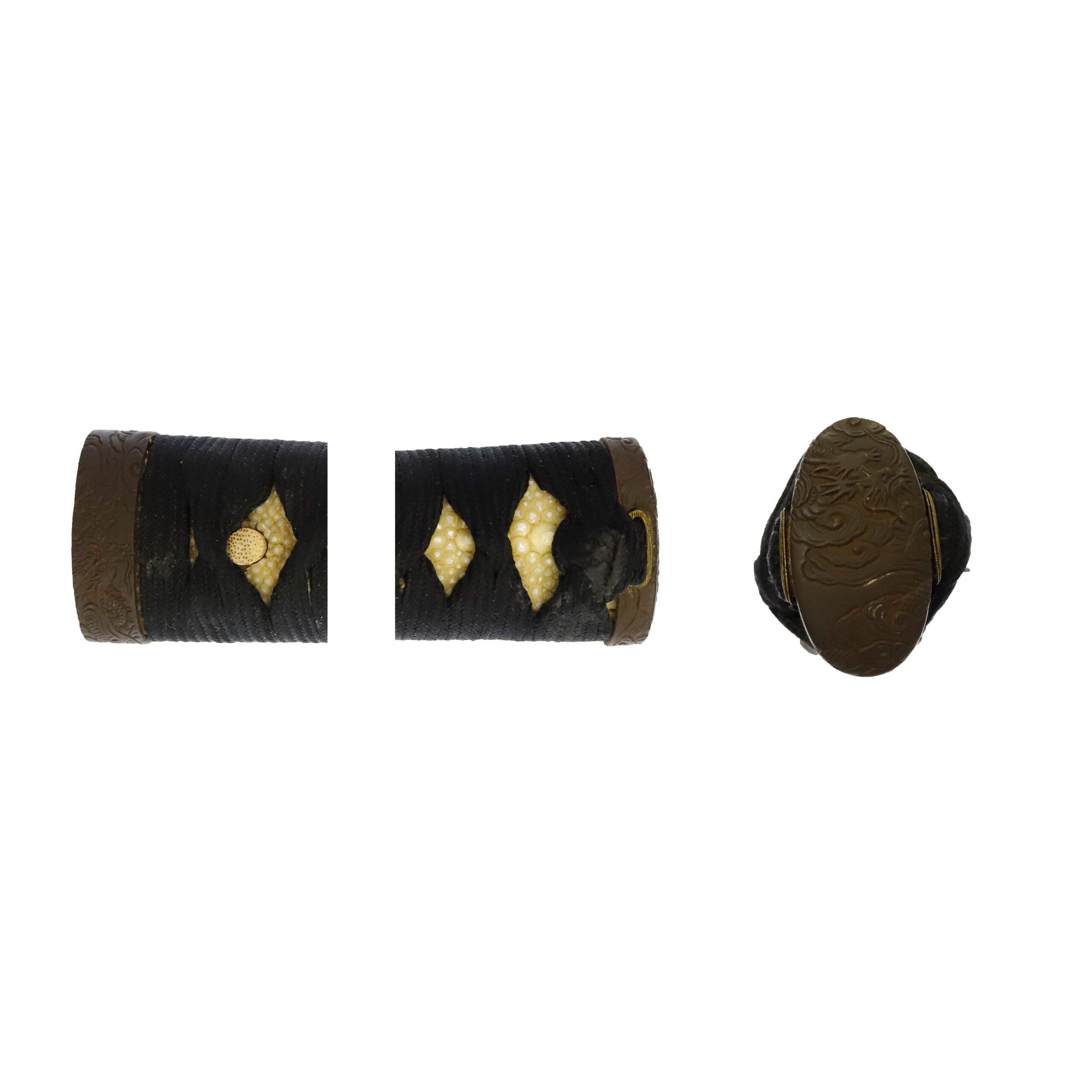
Tsuka and Menuki: Tsuka is the handle of the Japanese sword and Menuki is its decoration.
Judging from the shape visible through gaps of the Tsukamaki thread, this Menuki’s motif is likely an Ebi (海老, shrimp) design.
Among shrimp patterns, Iseebis (伊勢海老, spiny lobster) have been also modeled. According to a theory, Japanese people already ate shrimp in the Heian period (794-1185). However, it was an expensive ingredient for ordinary citizens, so only the nobility and high-class people could enjoy it. People started using shrimp as a good-omen pattern and appreciated designing it for their family crests in the Muromachi period (1336-1573).
In the Samurai’s society, as a shrimp is covered with a hard shell, it was thought that a shrimp represents the figure of a brave Samurai who wears armor. It has the meaning that wishes the fate of a Samurai will last for a long time. Shrimps have been likened to older adults because of their long feelers. Also, shrimps actively jump even though they are bowed. That is the reason why the shrimp pattern is treated as a symbol of perpetual youth and longevity. This animal shed its molt several times to grow up; therefore, some people have considered it is a symbol of success in life.
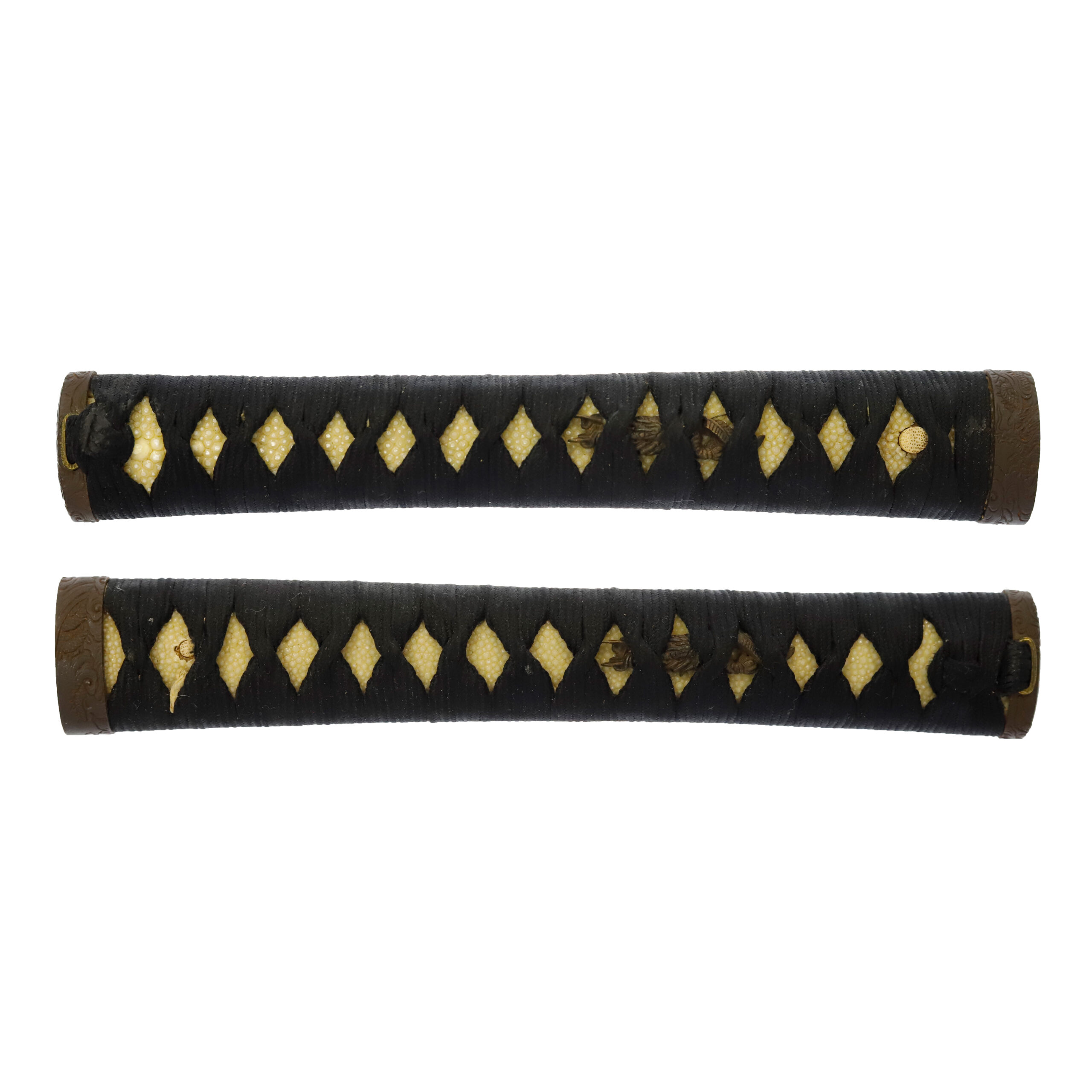
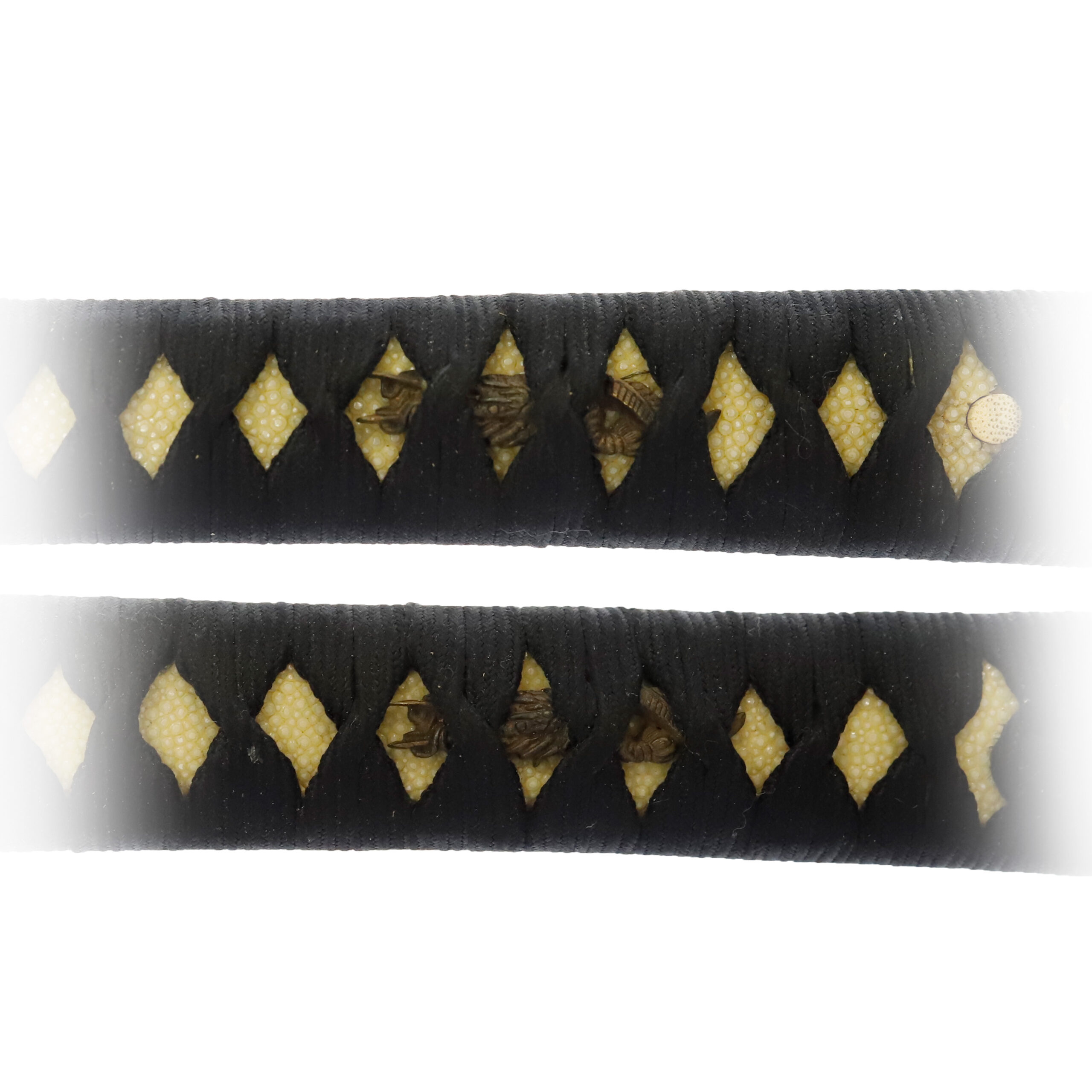
Tsuba and Habaki: Tsuba is the handguard for the Japanese Sword and Habaki is the equipment to make the blade not touch its scabbard inside. It prevents the blade from getting rusty and chipped.
The combination of Sensu (扇子, fan) and family crests is the theme of this Tsuba. While some colorings have already faded due to aging, golden paint is applied to fan patterns. It adds decorativeness to this work. This motif has been favored as an auspicious pattern representing development and prosperity. During the Heian period (794-1185/1192), aristocrats enjoyed elegant plays with fans, and they appreciated the fan itself as a noble item. A fan has a characteristic shape, and it is called Suehirogari (末広がり) in Japanese. Based on the idea that this shape implies a perspective of the future, people appreciate this design. The fan pattern also represents wealth because it was once available only for high-ranked people. In addition, people enjoy drawing various motifs such as animals, plants, geometric patterns, and auspicious patterns on the fan surface. That might also be why the fan motif is popular.
Other motifs of this Tsuba are two types of family crests. One of these plant patterns is probably the Kikyou (桔梗, Japanese bellflower). Japanese bellflower is a small star-shaped flower and is one of the Aki-no Nanakusa (秋の七草, seven herbs of autumn). It is said its root has medicinal efficacy. The Kikyou pattern has often been used as a motif of Tanka (短歌, a kind of traditional Japanese poem) and pictures since the Heian period (794-1185). Its name was initially “Kichikou,” and it changed to “Kikyou” with time. It is said this flower was used for fortune-telling in the old days. This action is called Kikkyou-wo Uranau (吉凶を占う) in Japanese. The word Kikkyou (吉凶, good or bad omen) was associated with this flower’s name. “Kichikou” was compared to the word “Kichi Kou (吉更),” which means further good fortune. That is why this flower pattern is treated as a good omen design.
Another family crest is the Katabami (片喰) designed crest. It is a plant whose leaf has a heart mark shape. People thought this plant design represented the prosperity of descendants; therefore, many Samurai cherished this pattern. In addition, this plant was favored for its strong vitality that did not wither even when trampled as a weed. It is said that people have associated with the Samurai by incorporating the sword motif. Understandably, lots of Samurai families used the Ken Katabami pattern. It shows the relationship between this plant motif and the Samurai culture.
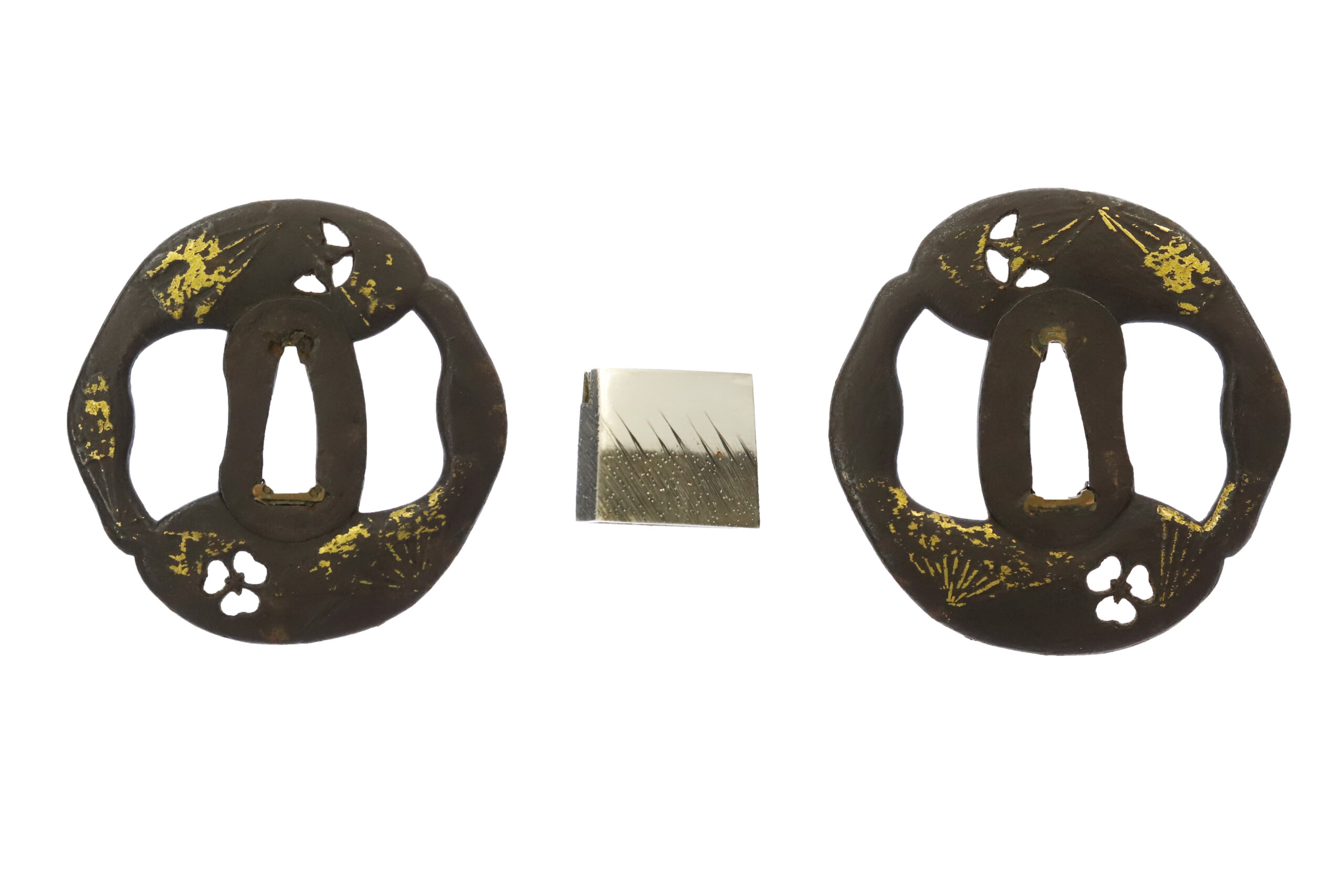
Saya: Saya is the scabbard for the Japanese sword.
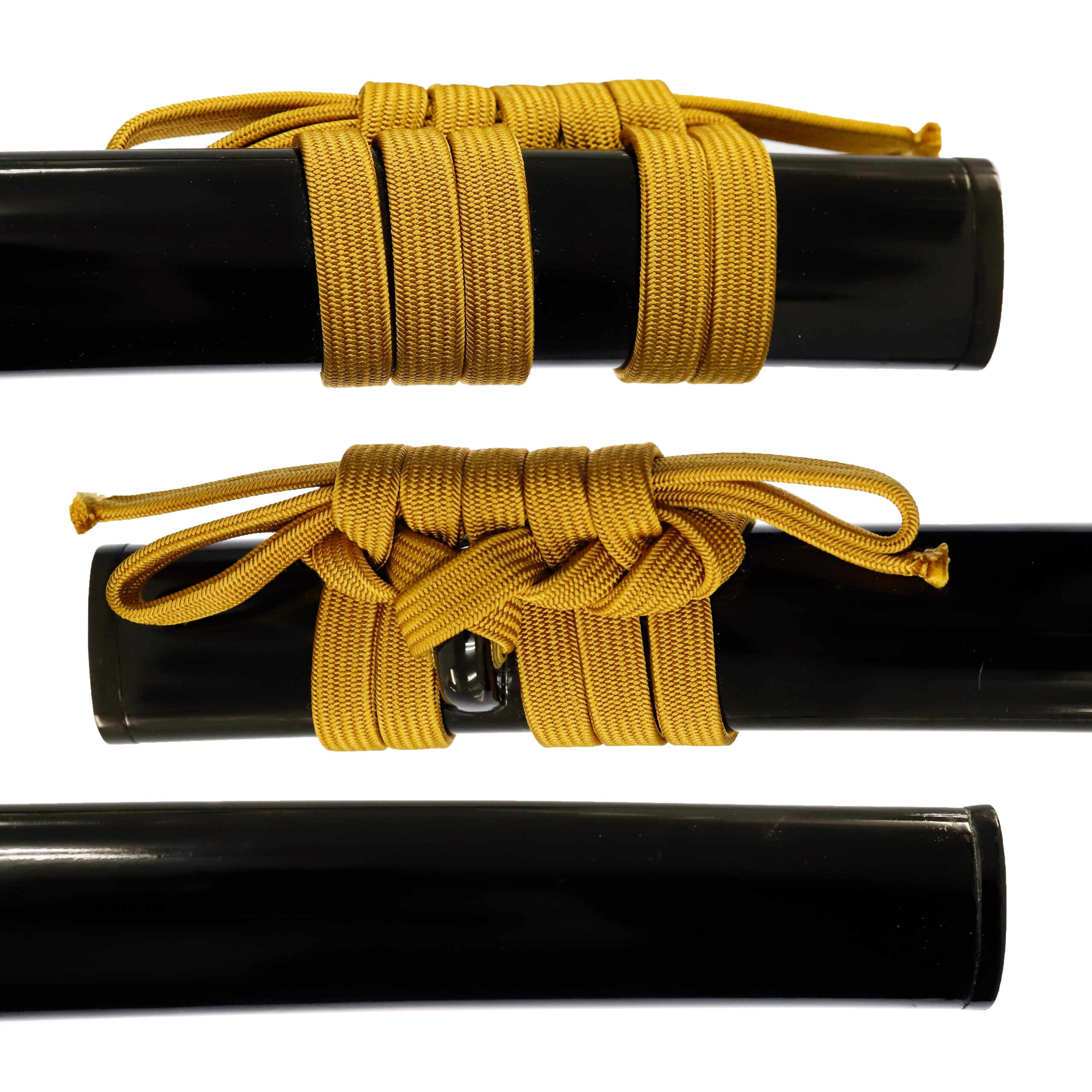
Authentication Paper: NBTHK Hozon Certificate for the blade (No.3032443)
NBTHK, also known as Nihon Bijutsu Touken Hozon Kyokai (the Society for the Preservation of the Japan Art Sword), is one of the oldest Japanese sword appraising organizations in modern-day Japan. They authenticated the blade on August 25th in the 5th year of Reiwa (2023). They appraised it as Hozon Touken, the blade worth preserving for Japanese society. The purchaser will receive this original certificate as well. We can also translate what is written into English and make a PDF file for your record if you request.
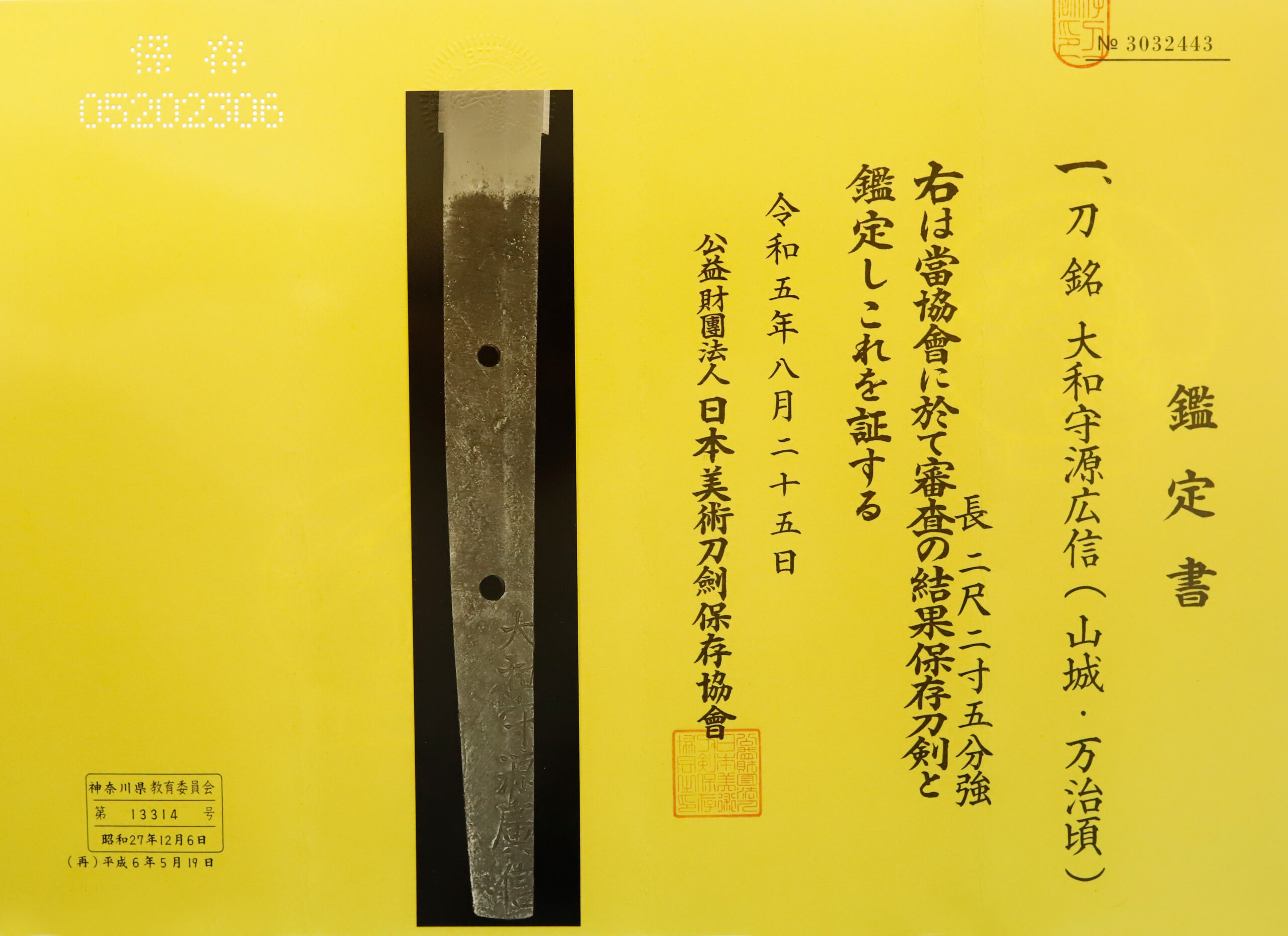
Registration Number: Kanagawa 13314
The Board of Education in Kanagawa prefecture issued a registration paper for this sword. It is called Jyu Token Rui Torokusho (銃刀剣類登録証). Bunkacho (The Agency for Cultural Affairs) acknowledges a Japanese sword with this paper as a work of art.
The sword needs to be traditionally hand-forged and made of Tamahagane carbon steel to be registered in the system. With this paper, its owner in Japan can legally own an authentic Japanese sword. Based on this registration number, we will apply for its export permit.
This paper will need to be returned to the board of education when the sword is being shipped abroad, but you can receive a copy of it. An English translation of this registration paper is available on request.
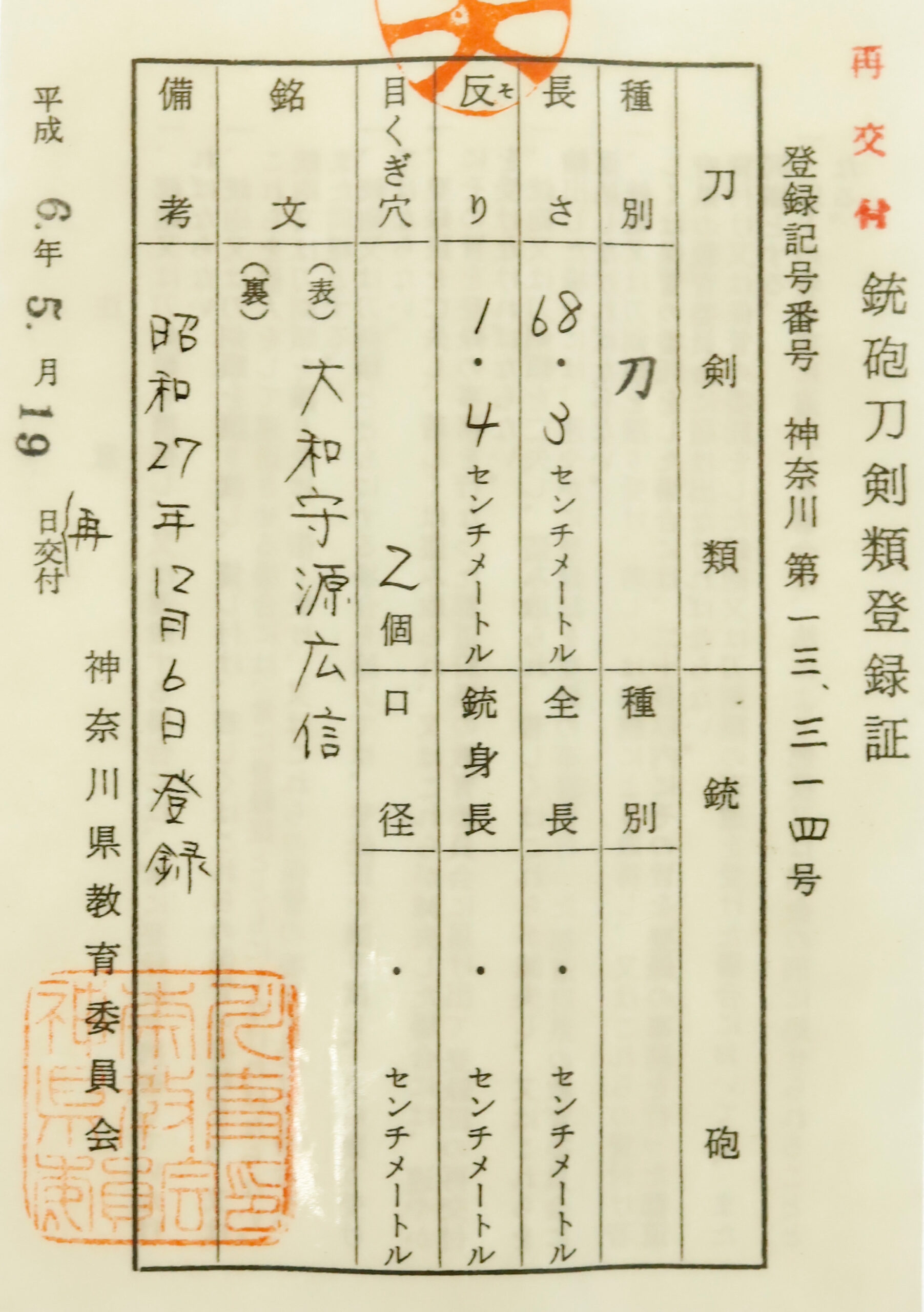

【About us】
Samurai Museum is located in Tokyo, Japan, exhibiting antique artifacts related to the Samurai history. Samurai Museum Shop is the place for those who are interested in Japanese culture and craftsmanship. We deal with antique Samurai swords/armor, traditional crafts made in Japan and so on.
【Review】
Here is one of the reviews we received from a customer who purchased an authentic Japanese sword from us. For more reviews, please click here.
“My experience overall with the whole process was wonderful. I had many questions about the history and process to purchase these treasures. All my questions were answered very timely and complete. The staff is very knowledgeable and very well versed if any questions do arise.”
【Japanese Sword& Export Process】
The Japanese swords we deal with are hand-forged edged swords made in Japan. It was made from the traditional carbon steel called TAMAHAGANE (玉鋼). Samurai Museum is familiar with the proper legal procedure for an antique/ authentic Japanese sword to be exported from Japan. We have sent more than 500 Japanese swords for the past three years (~2023) to amazing owners who appreciate its historical value.
Each Japanese sword is registered under the Agency for Cultural Affairs and the Board of Education in Japan. They issue a registration paper for each Japanese sword for its owner in Japan to legally possess it. The Japanese sword with its registration paper means it was traditionally hand-forged in Japan.
To legally export the sword from Japan to other countries, we will have to apply for its permit to the Agency for Cultural Affairs (Bunkacho) and return the original registration paper to the Board of Education. It normally takes around 2-4 weeks to receive this permit after submitting required documents. And we would like you to expect at least 1-1.5 months for your order to arrive at your given address after you ordered. For more detailed info, please click here.
It is allowed for residents in Japan to own authentic Japanese swords without a special license as long as they come with registration papers. Please feel free to contact us if you are a resident of Japan, whether temporarily or permanently. We will also assist you when you leave Japan and need to obtain the export permit.
【Payment Method】
We accept payment through Stripe (Credit card), PayPal, Apple Pay or ChromePay, all of which are secure payment methods. Also, you don’t need to make an account on Stripe for the checkout. If you prefer other payment method, please contact us. After confirming your payment, we will apply for an export permit. You may either pay in JPY, USD, AUD, CAD, EUR, CHF or GBP. The price is set in Japanese Yen. Prices in other currencies are automatically calculated based on the latest exchange rate.

*If the amount is above 1 million JPY, Stripe or wire transfer will be the only options for payment.
【Shipping】
We have shipped authentic Japanese swords to the USA, UK, Canada, Mexico, Germany, France, Hong Kong and Australia. If you don’t live in these countries and like to order, please contact us first before making a purchase. We offer Free International Shipping as long as we can send antique Japanese swords by EMS.
We normally ship by EMS (Express Mail Service) provided by Japan Post. We will send you a tracking number for your order as soon as we hand it to the post office. We will put 100 % insurance on the shipping document without any extra charge. Based on the total amount, there might be a duty tax or other fee for you to pay, depending on the countries. We use package cushioning to protect the item and put it in a PVC pipe, which is one of the most secure packages because of its durability.
It will normally take 5-14 days for the item to arrive at your given address after we dispatch it. Time of delivery is estimated as accurately as possible by the carrier but does not take into account any delays beyond our control such as by inclement weather, post office holiday seasons.
*If you live in Australia and like to purchase an authentic Japanese sword, please click here to know the detail.
*Please keep in mind that due to the spread of COVID-19, there might be delays in shipping. If you like to know the detail about shipping, please feel free to ask us.

【How to make sure the condition】
Please keep in mind that what you are going to purchase is an antique item. We uploaded high resolution photos for you to check its condition thoroughly. If you like to see more photos with different angles, please feel free to contact us. We will be happy to send them to you so that you can make informed decision. It is essential for us to know that you are happy with your choice of a sword. and we are prepared to use the best of our ability to serve you.
【How To Contact Us】
Please contact us through email, Facebook Messenger or Live Chat if you have any questions. You can find each icon on the right side of the website. Please click one of them to reach us. We will reply to you within 1-2 business days.
【The Art of Nihonto (Japanese Sword) 】
Samurai’s history is a profound, eloquent legacy of ancient Japanese warriors in which millions of people worldwide are being fascinated. If you like to find out the art of Nihonto, please click here.
【A Guide to Japanese Sword Maintenance】
After acquiring a genuine Japanese sword, it is also important to know how to take good care of it. Here is the special video for you. Mr. Paul Martin, Japanese sword expert, shows you how to give proper maintenance to your sword. By mastering how to clean the Japanese sword, its aesthetic beauty will last forever.
When you purchase a Japanese sword from us, you can get a Free Japanese sword maintenance kit. It comes with four tools (Choji Oil, Uchiko Whetstone Powder, Peg remover, Oil Applicator). By watching the video instruction above, you can enjoy learning how to maintain your Japanese sword while appreciating it. If you have any difficulty assembling the sword or cleaning the blade, you can feel free to contact us.


MORE ANTIQUE JAPANESE SWORD FOR SALE
SWORDS WITHOUT CERTIFICATES FOR SALE
LEARN JAPANESE SWORD TERMINOLOGY
Thank you for reading all the information on the page. If you have any difficulty choosing the right Japanese sword for you, we will be more than happy to help you find the one that speaks to you the most. Please feel free to contact us.
